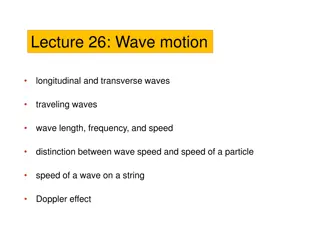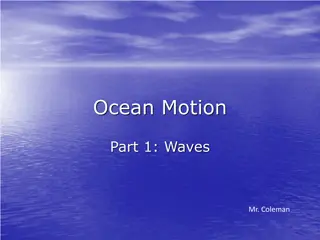Understanding Sound Waves: Exploring Wave Phenomena in Physics
Delve into the intricacies of sound waves in Physics with a focus on standing waves, boundary conditions, amplitude variations, and wave interactions. Explore concepts like harmonic wave addition, pulse encounters, and outcomes at fixed and free ends of a string. Discover how different scenarios affect wave propagation and reflection in various mediums.
Download Presentation

Please find below an Image/Link to download the presentation.
The content on the website is provided AS IS for your information and personal use only. It may not be sold, licensed, or shared on other websites without obtaining consent from the author. Download presentation by click this link. If you encounter any issues during the download, it is possible that the publisher has removed the file from their server.
E N D
Presentation Transcript
Sound I Physics 2415 Lecture 27 Michael Fowler, UVa
Todays Topics Standing waves as sums of traveling waves Boundary conditions Longitudinal waves: sound Amplitude and pressure variations Strings and pipes
Harmonic Wave Addition Two harmonic waves of the same wavelength and amplitude, but moving in opposite directions, add to give a standing wave. Notice the standing wave also satisfies f = v, even though it s not traveling!
Pulse Encounter It s worth seeing how two pulses traveling in opposite directions pass each other: And here s an animation.
The (Fixed) End of the String What happens when a pulse reaches the end of the string, and the end is fixed? A. It will decay B. It will bounce back, looking much the same. C. It will bounce back, but an up pulse will become a down pulse on reflection.
The (Free) End of the String . What happens when a pulse reaches the end of the string, and the end is free? (Meaning the string is attached to a ring which can slide freely on a rod in the y-direction.) A. It will decay B. It will bounce back, looking much the same. C. It will bounce back, but an up pulse will become a down pulse on reflection.
Strings Attached Suppose a black string and a less heavy red string are joined and pulled so the tensions are equal. A pulse is sent down the heavier black string. What happens after it gets to the join? A. It continues with larger amplitude along the lighter red string. B. It part continues, part reflected with same sign. C. Part continues, part reflected with opposite sign. Solution
Sound Wave in a Tube animation . Rest position of air slices Local longitudinal displacement D at time t Position of displaced air slices at instant t Note! For the amplitude of longitudinal displacement, we ll use D instead of A.
Clicker Question For a traveling sound wave going down a tube, at the instant t shown below, where is the air density greatest? .
The density is greatest at B where the difference D between the displacements sandwiching a slice is most negative that is, where the slope of D is most negative: . Rest position of air slices Local longitudinal displacement D at time t Position of displaced air slices at instant t If the original (imaginary) slices have thickness x, the fractional change in volume as the wave passes V/V = D/ x .
Clicker Question For a traveling sound wave going down a tube, at the instant t shown below, where in the wavelength is the pressure equal to atmospheric pressure ? A. Only A B. Only B C. Only C D. A and C E. B and D y D A B C x y = longitudinal displacement D(x,t) at instant t
The pressure variation from atmospheric (rest) pressure is given by P = -B( V/V) = -B( D/ x), so P = 0 where D has zero slope as a function of x: that is, P = 0 where the amplitude of D is largest: at A and C. . Rest position of air slices Local longitudinal displacement D at time t Position of displaced air slices at instant t If the original (imaginary) slices have thickness x, the fractional change in volume as the wave passes V/V = D/ x .
Amplitude and Pressure in a Harmonic Wave We found the pressure deviation from rest (atmospheric) pressure in a slice to be: = V D x D x = = P B B B V the last expression comes from taking the limit of very thin slices. So for we have ( ) sin D A kx t = ( ) = cos . P BAk kx t
Power and Loudness of Sound A sound wave delivers energy to any surface that absorbs it, the unit of power is watts per square meter of area perpendicular to the direction of the wave. Experimentally, the least power the human ear can detect is about I0 = 10-12watts/m2, the most (without pain!) is about 1 watt/m2. With this vast range, we must measure power I on a logarithmic scale: we define the decibel dB by I I (in dB) = 10log 10 0
Listening Far Away In the open air, the power from a source of sound radiates outward in a hemisphere, so twice as far away it s moving through a surface four times larger. This means power attenuates with distance as the inverse square, 1 r I 2 Note: If a significant fraction of the energy is in surface waves, such as in an earthquake, for that fraction the power goes down only as 1/r.
How Loud Does It Sound? . The phon is a unit of loudness: it s defined as equal to the dB at 1000Hz. (But it s not SI nor official US. It s somewhat subjective, curves vary.) To make a 20Hz signal sound as loud as a 1000Hz signal takes a million times the power!
Amplitude of a Sound Wave The expression for power/unit area delivered by a sound wave is the same as a string, with the string mass/unit length simply replaced by density/m3 (since this is mass/m for sound traveling down a pipe with cross-section 1 sq m). Power/sq m is sound intensity: At the threshold of hearing at 1000Hz the amplitude is of order 10-11m, P 10-10 atm. = v f A 2 2 2 2 I
Harmonic String Vibrations Strings in musical instruments have fixed ends, so pure harmonic (single frequency) vibrations are sine waves with a whole number of half-wavelengths between the ends. Remember frequency and wavelength are related by f = v ! String length L 1st harmonic (fundamental) = 2L 2nd harmonic = L 3rd harmonic = 2L/3
Longitudinal Harmonic Waves in Pipes What are possible wavelengths of standing harmonic waves in an organ pipe? Unlike standard string instruments, organ pipes can have two different types of end: closed and open. Obviously, longitudinal vibrations have no room to move at a closed end: this is the same as a fixed end for a transversely vibrating string. But what does the wave do at an open end?
Boundary Condition at Pipe Open End At an open end of a pipe, the air is in contact with the atmosphere so it s at atmospheric pressure. The boundary condition at the open end is that the pressure is constant, that is, P = 0. This means the amplitude of longitudinal oscillation is at a maximum at the open end!
Harmonic Modes in Pipes One end closed, one open: = 4L = 4L/3 Clicker question: what is the next value of ? A. L B. 4L/5 C. 2L/3 D. L/2
Clicker Answer = 4L/5: Both ends open: fundamental has = 2L.























